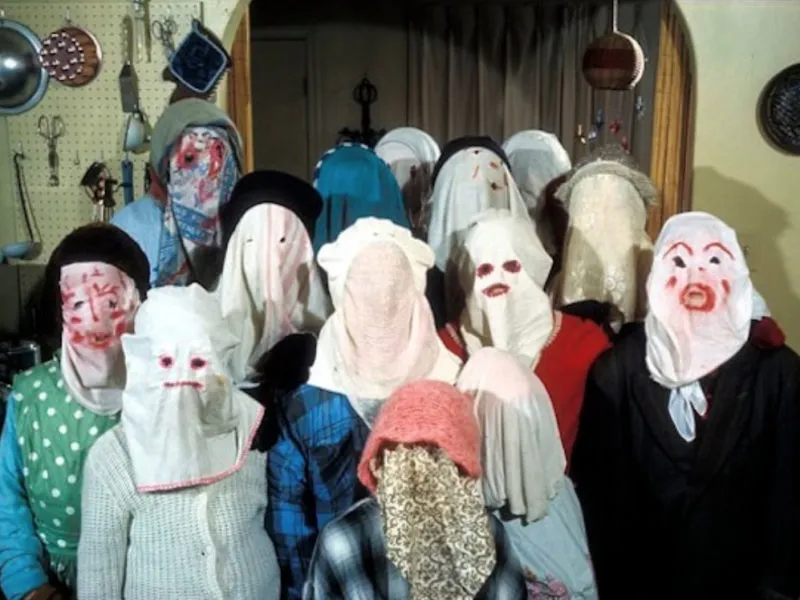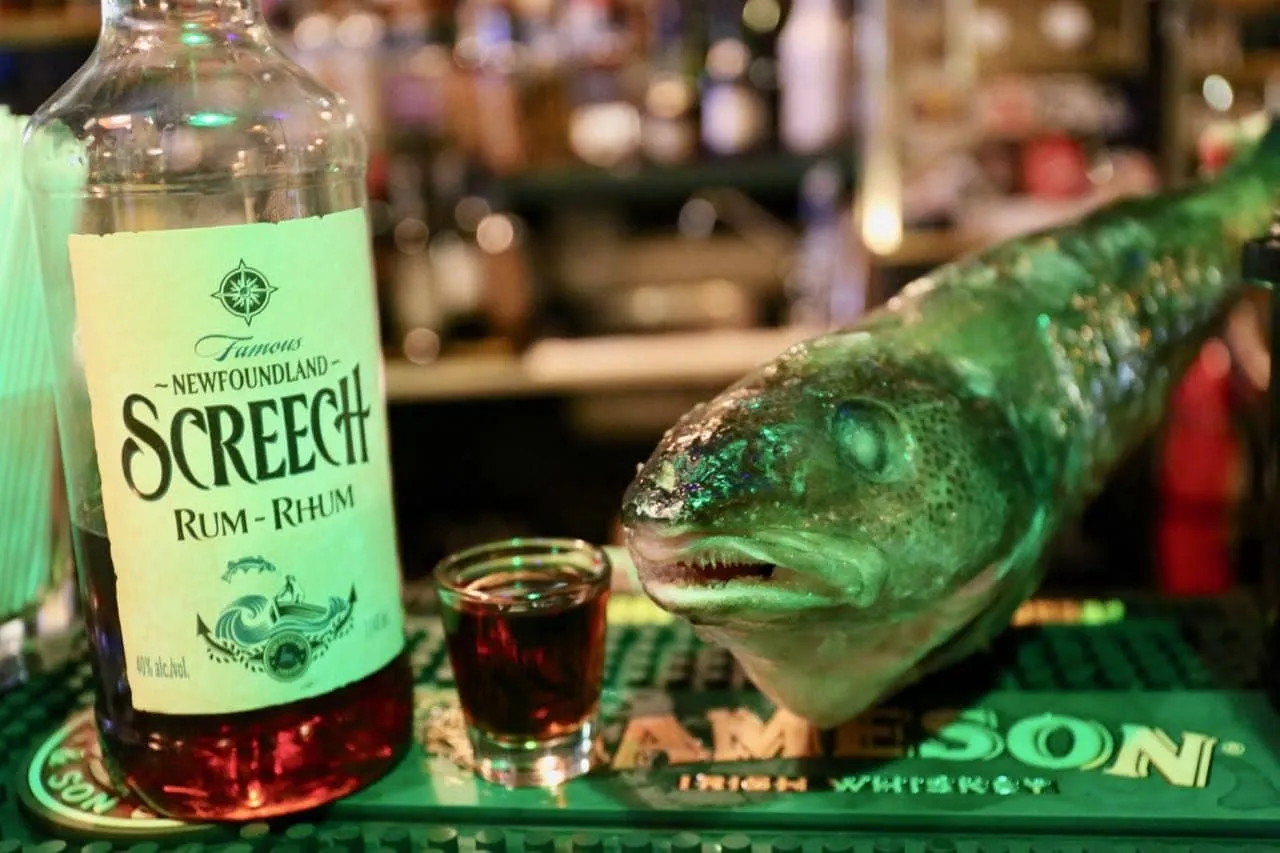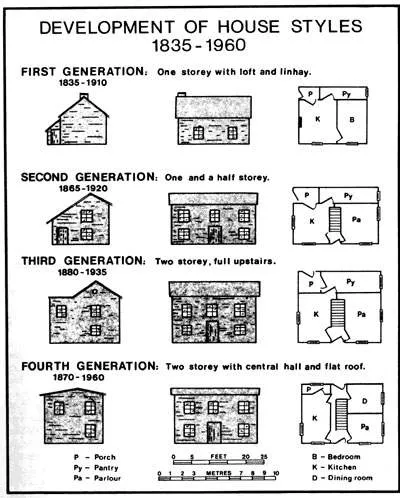Newfoundland Traditions & Folklore
Jiggs Dinner
According to urban legend, there are more than a few origin stories
for the name "Jiggs Dinner". Once legend recalls the
Newfoundlanders' adoration of a kitchen party and that they all love
to dance and do a jig in the kitchen supposedly while the pot is on
the boil. Another recalls that the salt beef, the most necessary
item in the pot, was imported from New York by a company called
Jiggs. One more suggests the way you would extract those boiled
vegtables and bag of pease pudding out of the pot is reminiscent of
jigging a codfish. While the name "Jiggs Dinner" didn't come around
until the turn of the 20th. century. It's components have
long been part of the Newfoundland and Labrador culinary cannon.

The meal most typically consists of salt beef (or salt riblets), boiled
together with potatoes, carrot, cabbage, turnip, and greens. Pease pudding
and figgy duff are cooked in pudding bags immersed in the rich broth
that the meat and vegetables create. Condiments are likely to include
mustard pickles, pickled beets, cranberry sauce, butter, and a thin gravy
made from the cooking broth. The leftover vegetables from a Jiggs dinner
are often mixed into a pan and fried to make a dish known as "cabbage
hash" or "corned beef and cabbage hash", much like bubble and squeak.
Mummering
Mummering is a Christmas-time house-visiting tradition practised in
Newfoundland and Labrador, Ireland, City of Philadelphia, and parts
of the United Kingdom.
An old Christmas custom from England and Ireland, mummering in a version
of its modern form can be traced back in Newfoundland into the 19th century.
Although it is unclear precisely when this tradition was brought to Newfoundland
by the English and Irish, the earliest record dates back to 1819. Some
state that the tradition was brought to Newfoundland by Irish immigrants
from County Wexford. The tradition varied, and continues to vary, from
community to community. Some formal aspects of the tradition, such as
the mummers play, have largely died out, with the informal house-visiting
remaining the predominant form.
On June 25, 1861, an "Act to make further provisions for the prevention of Nuisances" was introduced in response to the death of Isaac Mercer in
Bay Roberts. Mercer had been murdered by a group of masked mummers
on December 28, 1860. The Bill made it illegal to wear a disguise in
public without permission of the local magistrate. Mummering in
rural communities continued despite the passage of the Bill,
although the practice did die out in larger towns and cities. In the
1980s, mummering experienced a revival, thanks to the locally
popular musical duo Simani, who wrote and recorded "Any Mummers Allowed In?" (commonly referred to as "The Mummer's Song") in 1982.
Folklorist Dr. Joy Fraser has noted that, in common with many other
folk revivals, the resurgence of Christmas mummering in Newfoundland
is largely based on a selective and idealised conceptualisation of
the custom.

As part of this revival, one particular form of mummering - the informal
house-visit described above - has come to represent the custom in Newfoundland
as a whole, while other forms that were equally prominent in the island's
cultural history have received comparatively little attention. In 2009,
the Heritage Foundation of Newfoundland and Labrador's Intangible Cultural
Heritage office established what would become an annual Mummers Festival,
culminating in a Mummers Parade in St. John's. The success of the festival
has influenced, in part, another revitalization and increase of interest
in the tradition in the province.
Tibs' Eve
Tibb's Eve, Tip's Eve, Tipp's Eve or Tipsy Eve are regional
variations used throughout Newfoundland and Labrador to describe the
same celebration. Eventually, proverbial explanations arose as to
when this non-existent Tibs Eve was: "Neither before nor after
Christmas" was one. "Between the old year and the new" was another.
Thus, the day became associated with the Christmas season. Sometime
around World War II, people along the south coast of Newfoundland
began to associate 23 December with the phrase 'Tibb's Eve' and
deemed it the first night during Advent when it was appropriate to
have a drink. Advent was a sober, religious time of year and
traditionally people would not drink alcohol until Christmas Day at
the earliest. Tibb's Eve emerged as an excuse to imbibe two days
earlier. For some people, Tib's Eve is the beginning of the
Christmas season.

Observed on December 23rd and sometimes called Tip's Eve or Tipsy Eve,
it's one of several extensions of the holidays. For many Newfoundlanders,
this day is the official opening of Christmas, the first chance to drink
the Christmas stash. The date of Tib's Eve is only known in Newfoundland.
The tradition of celebrating Tibb's Eve may be similar to 19th century
workers taking Saint Monday off from work.
An outport tradition not originally celebrated in St. John's, Tibb's Eve was adopted circa 2010 by local bar owners, who saw it as a business opportunity. Brewery taproom owners have suggested that hosting Tibb's Eve events allow them to open up "Newfoundland experiences to outsiders. "The informal holiday has been also used for fundraising efforts, including the "Shine Your Light on Tibb's Eve" fundraiser for the St. John's Women's Centre, first organized circa 2009 in St. John's, and Tibb's Eve charity drives organized by the Masons in Grand Bank, NL. Since then, social media and expatriate Newfoundlanders have spread the tradition to other parts of Canada, such as Halifax, Nova Scotia and Toronto, Ontario. In 2014, Grande Prairie Golf and Country Club in Alberta hosted a Newfoundland-themed Tibb's Eve event, in support of local charities. In 2016, Folly Brewpub in Toronto brewed its own "Tibb's Eve" spiced ale. In 2019, comedian Colin Hollett described the holiday this way for a Halifax "Tibb's Eve on December 23, when people drink and eat at kitchen parties and bars with all the people they want to celebrate with before spending time with those they have to. I have no idea how that isn't huge everywhere else." The concept of the day being the "official" start of the Christmas holiday season was promoted in local media by 2020. In 2021, several Newfoundland bars hosted Tibb's Eve ugly Christmas sweater events, while Port Rexton Brewery produced a "Tibbs the Saison" beer.
St. Patrick's Day
Because of the time zone, Newfoundland is the first spot in North
America to celebrate St. Patrick's Day, just a few hours after it's
officially St. Patrick's Day in Ireland. Every year, St. John's is
the first capital city in North America to officially kick off St.
Patrick's Day. If you're in North America and want to get close to
Ireland, the closest spot is in Newfoundland. St. John's Harbour is
the closest North American port to Ireland and Cape Spear is the
closest point of land, which is just a short drive from St. John's
Harbour.
Often times when people from Newfoundland travel internationally they're
mistaken for being Irish because of the way they speak. Since many parts
of Newfoundland were originally settled by people from Ireland, many
residents in Newfoundland are direct descendants of Irish immigrants,
retaining much of the same dialect and accent. Most people are wearing
green, restaurants have special menus, and St. Patrick's Day celebrations
are everywhere. In Newfoundland, St. Patrick's Day is bigger than the
Easter Bunny and more popular than Black Friday
Sheila's Brush
If you live in Newfoundland, Sheila's Brush needs zero explanation.
It is a storm, usually a big storm that occurs on or after St.
Patrick's Day. It is typically the last big storm of the season. But
who is Sheila? The term comes from an Irish legend that says that
Sheila was the wife or sister or mother of St. Patrick and that the
snow is a result of her sweeping away the old season, which is
fitting since Spring begins later the week. There is also a legend
that Sheila shows up to punish Newfoundlanders for the heavy
partying that happens on St. Patrick's Day.

Do you believe in Sheila's Brush?.....
Garden Parties and Regattas
Throughout Newfoundland, churches have held Garden Parties to raise
funds for local parishes or for special projects. On some designated
day, usually a Sunday when fewer people would be working, a day-long
party is held outdoors, if the weather is fine, or in the church
hall, if not. With wheels of fortune, and races in the afternoon,
meals served at suppertime, and a dance at night, the festivities
would continue for hours.

In recent years the organization of such community-wide parties has frequently
devolved to town councils, and a weekday often in early August has been
set aside. In some larger towns the garden party became a regatta - Harbour
Grace, Placentia and St John's are three examples. The St John's Regatta
is the largest of these garden-parties-become-regattas; on the first
Wednesday in August (or the first fine day thereafter), the city stops
working and attends the boating races on Quidi Vidi Lake. Upwards of
30,000 attend every year, with estimates in some years of over 50,000
people attending the day-long event.
Shrove Tuesday
Pancake Night, or Shrove Tuesday, is typical of Newfoundland
calendar customs. Derived from widespread customs in European
traditions, and shaped as much by religious beliefs as by
traditional divinational activities, it is a mixture of traditions,
evolving continuously. Shrove Tuesday (named for the religious
practice of confessing one's sins and being "shriven" or "shrove" by
the priest immediately before Lent began) was a time to use up as
many as possible of the foods banned during Lent: meat products in
particular, including butter and eggs.

Pancakes were a simple way to use these foods, and one that could entertain
the family. Objects with symbolic value are cooked in the pancakes, and
those who eat them, especially children, take part in a divinatory game
as part of the meal. The person who receives each item interprets the
gift according to the tradition: a coin means the person finding it will
be rich; a pencil stub means he/she will be a teacher; a holy medal means
they will join a religious order; a nail that they will be (or marry)
a carpenter, and so on.
The 'Screech-In'
Perhaps the most controversial non-calendric custom in Newfoundland
in recent years is the Screech-In. It is historically related to
such traditions as equatorial line-crossing and initiation rites
known all over the world. It derives from "honorary Newfoundlanders"
rites of the 1940s and pranks played on new sealers going to the
ice. The Screech-In came into being in the 1970s when Joe Murphy and
Joan Morrissey put together an entertainment at the Bella Vista
Country Club in St John's. It included local musical performers and
a dress-up skit by which members of the audience were humorously
"screeched-in." In later years the Screech-In was widely performed
by Myrle Vokey and by employees of the Newfoundland Liquor
Commission. Typically, initiates are made to kiss a codfish, drink
some Screech (rum) and repeat a semi-dialect, slightly risqué
recitation.

In 1990 the custom came under fire from several directions and was attacked
as a destructive mocking of Newfoundland culture. The Premier at the
time, Clyde Wells, ordered the Liquor Commission to destroy "Order of
Screechers" certificates that bore his official signature. Nonetheless,
the Screech-In has continued in the 1990s as a widely favoured way of
welcoming visitors to Newfoundland with an entertaining ritual.
Newfoundland Architecture
The unique and striking architecture of Newfoundland has served to
draw many tourists to the province. The preservation of individual
structures is crucial to the tourist industry, and the economic well
being of communities. Many people are drawn towards our beautiful
old buildings and we, as Newfoundlanders, feel a strong pride that
goes along with the wood and nails. The preservation of Newfoundland
folk architecture in recent years has received deserving attention.
In Bonavista, for example, the community college has developed a
heritage carpentry course. Students learn how to reconstruct
heritage houses, and as a result they are also enriched with the art
of making traditional furniture. In Trinity, a number of local
carpenters have revived the making of traditional windows and have
created a market for these products throughout the province. Also,
an inventory of Newfoundland folk homes is being compiled as part of
a strategy to preserve Newfoundland's architectural heritage.

A distinguishing feature of the majority of houses in Newfoundland is
their wooden construction. The reason for this goes back to the seventeenth
century. When settlers first landed on our shores they could not ignore
the abundance of lumber around them. The style at the time in Europe
was to build with lumber so these New World settlers also built their
houses of wood.Availability of wood was not the only reason why they
chose lumber as the best material. Building a stone or brick house required
a great deal of time and money, neither of which was available to most
settlers. To build a stone or brick house required special skills and
many months of dry warm weather which Newfoundland does not always enjoy.
As well, bricks had to be shipped from England in order to have them
as a building material. Stone was not an acceptable building material
either, because the settlers would have to locate and operate an accessible
quarry.
First generation homes Sometimes referred to as a settlers house, these
homes were built most frequently from 1835-1910. These houses were very
rugged looking one storey dwellings and were made from rudimentary materials.
Second generation homes Better known as a salt box, these homes were
built most frequently from 1865-1920. The house pictured below was basically
a settlers house, but was built with higher quality materials. This house,
however, had one and a half storeys. Third generation homes This house
is also known as a salt box (modified). It was built most frequently
between 1880-1935. This house had two full storeys and was slightly larger
than the salt box. Fourth generation homes This house, the largest of
the folk houses, has two full storeys, a central half hall, and a flat
roof. This house, known as a biscuit box, was built most frequently between
1870-1960.

